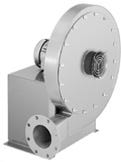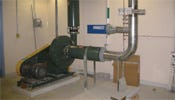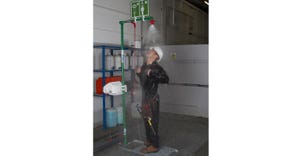Low-Pressure Pneumatic Conveying Fans for Drying, Dust Blow-Off, and Cleaning Applications
April 23, 2008
|
A pressure blower being used at a pharmaceutical plant to create a fluidized bed for a pill-coating operation. |
Single-stage blowers can offer tremendous operating-cost savings in low-pressure, dilute-phase pneumatic systems. Companies have used expensive compressed air for various drying, dust blow-off, air flotation, and cleaning operations. These blowers can also be used for vacuum service for parts hold-down, pneumatic conveying, and dust collection.
Standard single-stage, backward-curve-blade centrifugal fans can be supplied with efficiencies up to 80%. These fans provide oil-free, stable (no-surge) airflow with a nonoverloading horsepower characteristic. Fans of this size are found in printing dryer and metal-finishing systems with wide continuous conveyors. The fans can also be used for vacuum hold-down and air flotation chores in these same systems. Air-slide conveyors are used for gravity flow of hot granular and biosolid materials in the mining and chemical-processing business. The heating and cooling of the drying air can be accomplished for additional cost. High-efficiency filtration and silencing accessories are available. Direct-drive industrial fans and blowers that use standard frame motors are readily maintained and provide dependable service in 24/7 operating conditions.
|
Pressure blowers |
Pressure blowers provide relatively high pressures at low volume when compared with other types of centrifugal fans. For the purposes of this discussion, fans with volumes of 10,000 cfm to pressures of 140 in. water gauge (5.0 psig; 80 osi) are considered pressure blowers. Typical applications require constant pressure throughout the system’s operating range. Outlet dampers are usually used to control air volume while pressure follows the fan manufacturer’s curve values. Consequently, it is a requirement of pressure blowers that they provide stable performance from full-closed to full-wide-open air flow. The simplest pressure blowers employ a straight radial wheel design. These radial-blade wheels are inherently stable and produce moderate-efficiency performance. Pressure blower impeller designs have lower specific revolutions per minute and produce higher pressure and noise levels than other designs. Fan manufacturers have developed alternative designs with either slightly backward-curved or forward-curved blades. The volume and pressure characteristics of these designs remain close to those of radial-blade wheels without sacrificing stable performance conditions. These fan designs are generally directly coupled to a motor through a shaft and bearings, or they are directly mounted on the motor shaft itself. This results in greater reliability for continuously operating systems.
Single-stage pressure blowers are the most common and least expensive of the design choices for industrial systems. They can be provided in alloy and temperature ranges that are not available with multiple-stage and regenerative blowers. It is possible to design single-stage centrifugal blowers with extra-heavy-duty casings used in series to boost pressures beyond normal single-stage maximums while maintaining single-stage efficiencies.
|
An advanced wheel and aerodynamic housing design combine for air-handling efficiency that is superior to conventional radial-wheel designs. |
A primary concern in many of today’s industrial applications is the noise-level criteria. To meet these requirements, many pressure blowers require sound attenuation. The backward-curved, high-efficiency wheel design can result in an 8–10-dBA noise reduction over the traditional straight-blade designs. In some cases, this may make the difference between a suitable and an unsuitable installation. Another source of concern is the sound level of the electric motors driving the blowers. In some cases, traditional absorptive silencers are not sufficient, and complete noise enclosures are required. These noise enclosures, in turn, can require ventilation air in order to cool the machinery itself. This type of blower silencer package is best designed at the time of equipment purchase in order to gain minimum footprint and maximum noise-level reduction.
Selecting a pressure blower or any other type of fan for applications involving a relatively high pressure requires some special considerations. Pressure blowers are generally used with the pressure entirely on the inlet or entirely on the outlet. Air is compressed as it passes through the fan, lowering the volume and raising the density. In negative-pressure systems, air is rarefied to become less dense. The extent to which the effects of compression and rarefaction must be considered depends largely on the degree of accuracy employed in the actual system design and calculation process. During compression there is also a temperature rise associated with the energy expended to overcome the system resistance and blower inefficiency to determine the proper air volume for selection purposes. The effect on density of both compression and temperature must be considered.
Jeff Sostak is manager—technical support for The New York Blower Co., Willowbrook, IL, a manufacturer of fans and blowers for the industrial and OEM marketplace. Sostak can be reached at 630-794-5738 or [email protected]. For more information on the company, visit www.nyb.com.
About the Author(s)
You May Also Like







